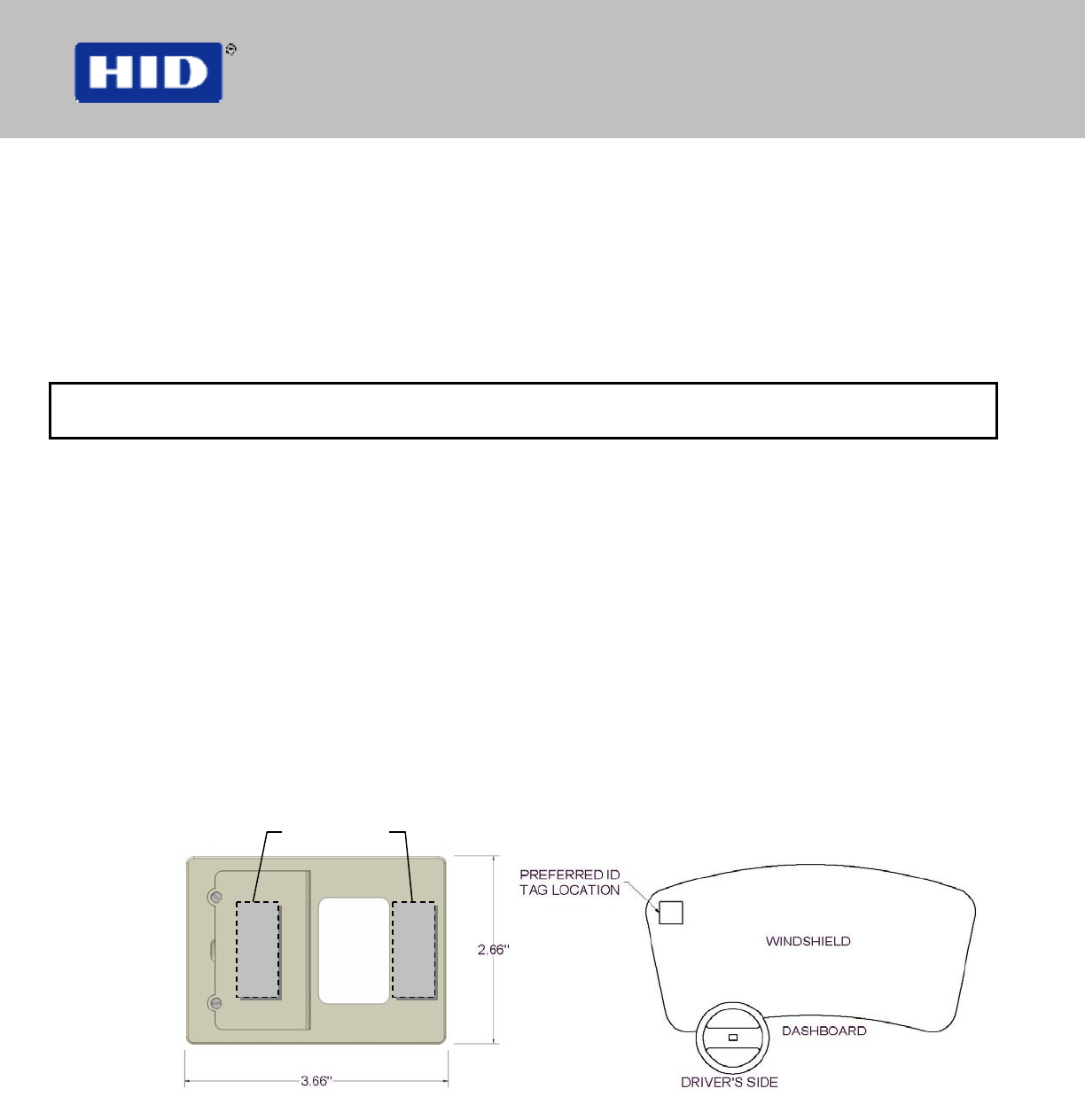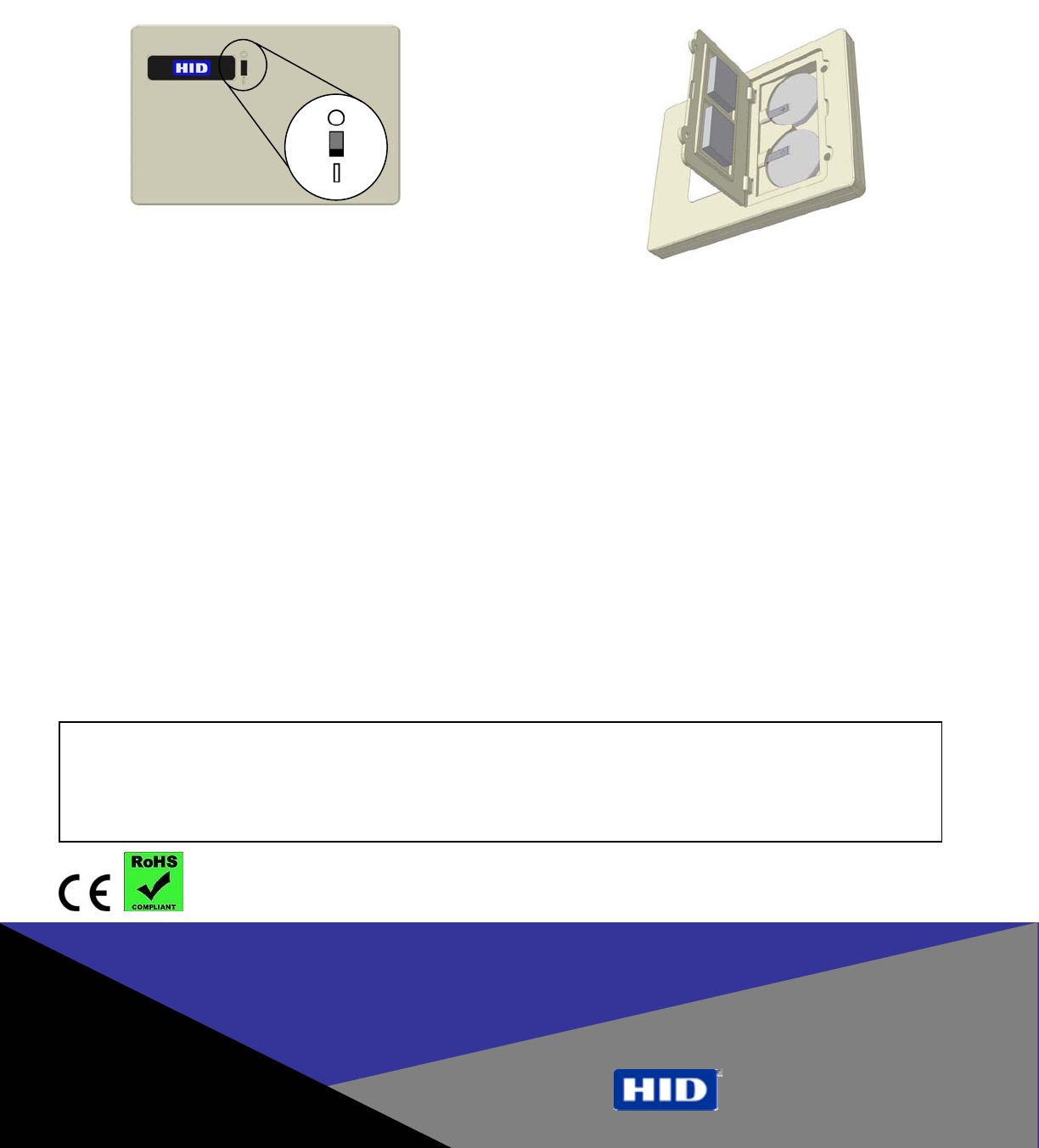HID Global 1351B ProxPass 1351 (1351-310) User Manual 1351 901 E 1
HID Global Corporation ProxPass 1351 (1351-310) 1351 901 E 1
Users Manual

Install Guide
Part No. 1351-901, Rev E.1
ProxPass
®
II
Vehicle Identification Tag
The ProxPass® II mounts to the inside of a vehicle’s windshield. Use the ProxPass II with the HID® MaxiProx® Reader
for vehicle access control. Velcro strips with an adhesive backing are provided for installation. For best results, mount
the tag to the upper corner of the driver’s side of windshield.
The tag has an operating frequency of 125 KHz, and a read range of 6-8 feet from the reader, depending on mounting
location, mounting angle and environmental conditions. The vehicle must be stopped or moving slowly in front of the
reader for the tag ID to be read. The tag is powered by two lithium batteries. Battery life may range from two to five
years, depending on frequency of use and length of exposure to extreme heat or cold. The tag unit is not sealed, and
should not be directly sprayed or submerged in water.
WARNING: THE BATTERY MAY EXPLODE IF MISTREATED. DO NOT RECHARGE,
DISASSEMBLE, OR DISPOSE OF THE BATTERY IN A FIRE!
Installation
1. Each tag is shipped individually and is switched off to prevent accidental activation during
transportation or storage. Leave the tag off until installed in the vehicle.
2. Determine the appropriate mounting location of the tag. Completely clean the mounting location using
rubbing alcohol or glass cleaner.
3. Cut two strips of Velcro® (keeping the two pieces, hook and loop, adhered together). Position and
place the strips firmly against the back of the tag, see Figure 1 ProxPass II Positioning.
4. Just prior to mounting the tag, remove the Velcro’s adhesive liner. Mount the tag unit to the
windshield, and apply even pressure on the entire surface to ensure adhesion.
5. Using a paper clip or the tip of a ballpoint pen, move the switch to the ON (I) position, Figure 2 Power
Switch. The tag is ready to use.
Figure 1 ProxPass II Positioning
PREFERRED
VELCRO
LOCATION

www.hidcorp.com
An ASSA ABLOY Group company
© 2006 HID Global Corporation. All rights reserved.
HID Global (California, USA)
support: tech@hidcorp.com
main: (949) 598-1600
support: 1-800-237-7769
fax number: (949) 598-1690
HID Corporation, Ltd. (Haverhill, UK)
support: eusupport@hidcorp.com
main: +44 (0) 1440 714 850
support: +44 (0) 1440 711 822
fax number: +44 (0) 1440 714 840
HID Asia Pacific Ltd. (Hong Kong)
support: asiasupport@hidcorp.com
main: (852) 3160 9800
support: (852) 3160 9802
fax number: (852) 3160 4809
Switch and Battery Replacement
Figure 2 Power
Switch
Figure 3 Replacing Batteries
1. When replacing the batteries use only Panasonic BR2330 batteries (two required). These are
available from Panasonic or a battery distributor and are not available retail.
Note: Although CR-type batteries (CR2330) are available in the same size and voltage, they are not
compatible with the ProxPass II. CR2330 batteries are not rated for the extreme temperatures which
are typical inside vehicle windshields.
2. Remove unit from vehicle windshield.
3. Slide the switch to the OFF (O) position, see Figure 2 Power Switch.
4. Remove the two battery door screws on the back of the unit (using a #0 or #1 slotted or Phillips tipped
screwdriver) and then open the door, see Figure 3 Replacing Batteries.
5. Remove and replace the old batteries. Use caution to orient the + terminals of the batteries outward –
toward the battery contacts also marked +.
6. Close the battery door and tighten the cover screws.
7. Reinstall the unit on the vehicle windshield.
8. Slide the switch to the ON (I) position.
CAUTION: Do not park a vehicle with a ProxPass II installed within 15 feet of a MaxiProx, as the tags will
continuously attempt to communicate with the reader, which reduces the battery life.
FCC Compliance Statement: This device complies with part 15 of the FCC Rules. Operation is subject to the following two
conditions: (1) this device may not cause harmful interference, and (2) this device must accept any interference received,
including interference that may cause undesired operation.
Changes or modifications not expressly approved by the party responsible for compliance could void the user's authority to
operate the equipment.